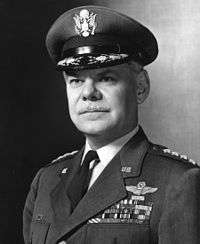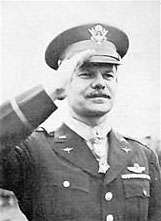Leon W. Johnson
| Leon W. Johnson | |
|---|---|
  General Leon W. Johnson | |
| Born |
September 13, 1904 Columbia, Missouri |
| Died |
November 10, 1997 (aged 93) Fairfax, Virginia |
| Buried at | Arlington National Cemetery |
| Allegiance |
|
| Service/branch |
United States Army Air Corps |
| Years of service | 1926-1965 |
| Rank | General |
| Commands held |
Continental Air Command 44th Bomb Group |
| Battles/wars | World War II |
| Awards |
Medal of Honor Air Force Distinguished Service Medal (2) Silver Star Legion of Merit Distinguished Flying Cross (2) Air Medal (4) French Legion of Honor French Croix de Guerre Belgian Croix de Guerre Distinguished Flying Cross (UK) |

General Leon William Johnson (September 13, 1904 – November 10, 1997) was a United States Air Force Four-star general and World War II Medal of Honor recipient.
Early life
Johnson was born in Columbia, Missouri, in 1904 and moved to Moline, Kansas, as a teenager.[1] He graduated from the United States Military Academy and was commissioned a second lieutenant in June 1926. He later received a master of science degree in meteorology from the California Institute of Technology.
World War II
He was one of the first four flying officers of the Eighth Air Force and served as assistant chief of staff for operations for that command and during its formative period at Savannah, Georgia. He accompanied the Eighth Air Force to England in June 1942. In January 1943, he assumed command of the 44th Bombardment Group and, in June of that year, took the group to Africa to assist the Ninth Air Force in the attack on the Ploesti oil fields in Romania. For his part in that raid, he was awarded the Medal of Honor.[2]
On his return to England in September 1943, he organized the 14th Combat Wing and commanded it until the end of the war in Europe.
Post World War II
After V-E Day, he was chief of personnel services, Headquarters Army Air Forces in Washington. He later became deputy to the assistant chief of air staff for personnel. From April 1947, he was commander of the Strategic Air Command Fifteenth Air Force at Colorado Springs, Colorado.
The Air Force returned to England for the first time since World War II when General Johnson organized the Third Air Division (later redesignated the Third Air Force) there in August 1948, as a separate major command of the U.S. Air Force. The division provided facilities for maintenance and support of Strategic Air Command aircraft on rotational training missions to Europe and for transport aircraft used in the Berlin Airlift. In February 1950, General Johnson was appointed, in addition to his other duties, chief of the Military Assistance Advisory Group for the United Kingdom.
In February 1952, he was named commander of the Continental Air Command at Mitchel Air Force Base, New York. From July 1953, he was concurrently U.S. Air Force Representative to the United Nations Military Staff Committee.
From 1956, he was U.S. Representative to the North Atlantic Military Committee, Military Representatives Committee, and NATO Standing Group, stationed in Washington, D.C.
In May 1958, General Johnson he was air deputy to the supreme allied commander Europe, at SHAPE Headquarters in Paris, France. On July 31, 1961, he retired with more than 34 years of military service. Six weeks later he was recalled to active duty to become director of the National Security Council Net Evaluation Subcommittee Staff at the Pentagon. After leaving the Air Force, he settled in McLean, Virginia and worked as a consultant. His hobbies included growing flowers, and he was president of the National Capitol Dahlia Society.
Awards and decorations
General Johnson was a command pilot and was promoted to general August 31, 1957.
| Medal of Honor | |
| Air Force Distinguished Service Medal with oak leaf cluster | |
| Silver Star | |
| Legion of Merit | |
| Distinguished Flying Cross with oak leaf cluster | |
| Air Medal with three oak leaf clusters | |
| Legion of Honor, grade of Chevalier (France) | |
| Croix de Guerre with palm (France) | |
| Groix de Guerre with palm (Belgium) | |
| Distinguished Flying Cross (United Kingdom) |
Death and legacy
He died on November 10, 1997 in Fairfax, Virginia, and was buried in Arlington National Cemetery next to his wife, Lucille Taylor Johnson, who had died in 1983. He was survived by two daughters,[3] one of whom married the son of General Hoyt S. Vandenberg.[4] In 2008, Johnson's grandson, Leon Abbott, donated his Medal of Honor to the U.S. Army Heritage and Education Center in Carlisle, Pennsylvania, which holds a large collection of material relating to the 44th Bomb Group.[1]
Medal of Honor citation
Rank and organization: Colonel, U.S. Army Air Corps, 44th Bomber Group, 9th Air Force.
Place and date: Ploesti Raid, Rumania, August 1, 1943.
Entered service at: Moline, Kans. Born: September 13, 1904, Columbia, Mo.
G.O. No.: 54, September 7, 1943.[5]
Citation:
:For conspicuous gallantry in action and intrepidity at the risk of his life above and beyond the call of duty on August 1, 1943. Col. Johnson, as commanding officer of a heavy bombardment group, let the formation of the aircraft of his organization constituting the fourth element of the mass low-level bombing attack of the 9th U.S. Air Force against the vitally important enemy target of the Ploesti oil refineries. While proceeding to the target on this 2,400-mile flight, his element became separated from the leading elements of the mass formation in maintaining the formation of the unit while avoiding dangerous cumulous cloud conditions encountered over mountainous territory. Though temporarily lost, he reestablished contact with the third element and continued on the mission with this reduced force to the prearranged point of attack, where it was discovered that the target assigned to Col. Johnson's group had been attacked and damaged by a preceding element. Though having lost the element of surprise upon which the safety and success of such a daring form of mission in heavy bombardment aircraft so strongly depended, Col. Johnson elected to carry out his planned low-level attack despite the thoroughly alerted defenses, the destructive antiaircraft fire, enemy fighter airplanes, the imminent danger of exploding delayed action bombs from the previous element, of oil fires and explosions, and of intense smoke obscuring the target. By his gallant courage, brilliant leadership, and superior flying skill, Col. Johnson so led his formation as to destroy totally the important refining plants and installations which were the object of his mission. Col. Johnson's personal contribution to the success of this historic raid, and the conspicuous gallantry in action, and intrepidity at the risk of his life above and beyond the call of duty demonstrated by him on this occasion constitute such deeds of valor and distinguished service as have during our Nation's history formed the finest traditions of our Armed Forces.[5]
See also
Notes
- 1 2 Greaney, T.J. (October 16, 2008). "Grandson donates local general's Medal of Honor". Columbia Daily Tribune. Retrieved 2008-10-20.
- ↑ Liberators over Europe, 1942 - 1945. US Army Air Forces. c. 1945. Retrieved February 20, 2012.
- ↑ Arlingtoncemetery.net entry
- ↑ Oil Paintings by David Johnson Vandenberg - Family History
- 1 2 "Medal of Honor recipients World War II (G–L)". Army Center of Military History. Retrieved 2009-04-10.
References
 This article incorporates public domain material from websites or documents of the United States Army Center of Military History.
This article incorporates public domain material from websites or documents of the United States Army Center of Military History.
![]() This article incorporates public domain material from the United States Government document "http://www.af.mil/bios/bio.asp?bioID=5964".
This article incorporates public domain material from the United States Government document "http://www.af.mil/bios/bio.asp?bioID=5964".
External links
| Wikimedia Commons has media related to Leon W. Johnson. |